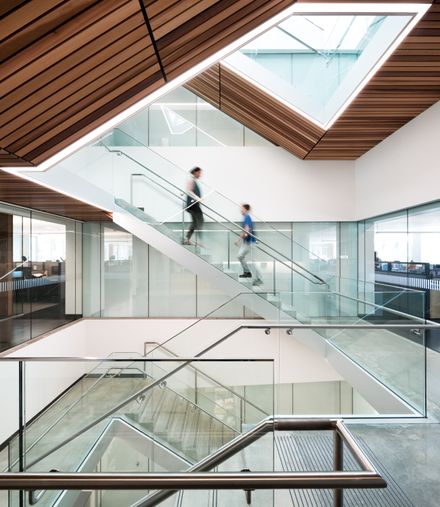
Surrey Operations Centre
ARCHITECTS
Taylor Kurtz Architecture + Design Inc.
PRIME CONSULTANT
Taylor Kurtz
BUILDING ARAEAS
95,000 sq.ft Operations Building; 14,000 sq.ft Storage Building; 48,000 sq.ft Fleet Maintenance Building
DESIGN LEAD
RDH
LEED STATUS
Silver registered
CONSTRUCTION COST
$53M
AREA
100,000 sqft - 300,000 sqft
BUDGET
$50M - 100M
COMPLETED
May 2015
YEAR
2016
LOCATION
Surrey, Canada
TYPE
Government + Health › City Hall
Conceived as a loose grouping of structures that mediate between public and industrial urban spaces, this project completely reconfigures and densifies the City of Surrey’s existing central operations centre and works yard site, providing a new design benchmark for this often neglected building type, and celebrating the work of those who build and maintain our municipal infrastructure.
Three new buildings are expressed as rectilinear bars of varying heights, responding to both the variety of program components and the complex needs of construction phasing, which required uninterrupted facility operations and the gradual removal of existing buildings.
Carefully considered north-south offsets define semi-sheltered interstitial zones for parking, social gathering, loading, and work staging.
A four storey office building is the public face of the project and houses departmental headquarters, a cafeteria, meeting rooms and training space; the adjacent single storey operations wing contains change facilities and workshops, the latter positioned to make their activity visible from the street.
The warehouse structure is partially buried to reduce its impact on the street and neighboring residences.
The fleet maintenance wing, at the center of the site, contains a repair garage, vehicle wash bays, and mechanics’ workshops, while the adjacent stores and operations wing, designed to meet post-disaster requirements, houses vehicle dispatch, a training room/emergency command centre, and general stores.
A storage outbuilding on the north property line provides acoustic and visual barriers protecting the surrounding residential developments.


Exterior cladding consists primarily of capless fritted curtain wall and prefinished metal panels.
Human-scaled access points are marked by cedar-lined recesses carved out of the facades; this wood finish is pulled into the public lobby to become the lobby ceiling and atrium stair soffit, providing continuity to the arrival experience.
The 4 storey, roof-lit atrium, with glazed break rooms overlooking the stair at each floor, facilitates interaction between the previously disparate departments, promoting collaboration through casual encounters.
Vertical bifold doors are typically seen on aircraft hangars and are repurposed here for fleet maintenance and workshop access.
Clad in glazed curtain wall, these high-performance doors provide an outdoor sheltered work zone when open, avoid the typical interference with ceiling-level mechanical systems and lighting, and achieve visual continuity with the overall building envelope.
The facility is targeted to achieve LEED Silver Certification and is to be 40% more energy efficient than a typical Operations Building.
Green strategies include a sophisticated Building Management System, heat recovery units, LED light fixtures, low volume plumbing fixtures, occupancy light sensors, operable windows and fully glazed overhead doors that provide natural ventilation and deep daylight penetration to both administrative and operations work areas.


















